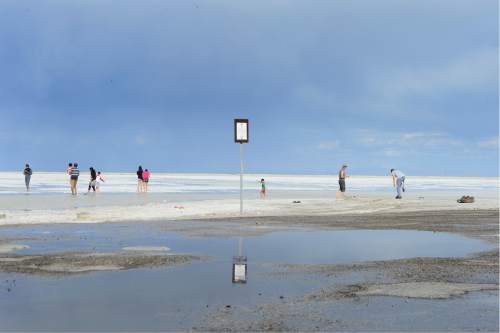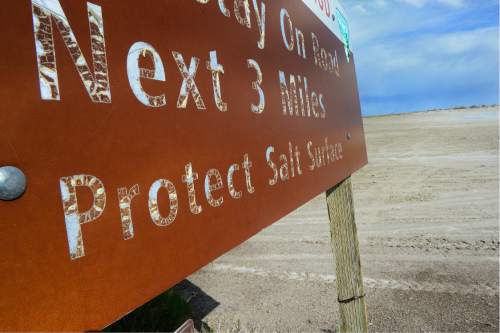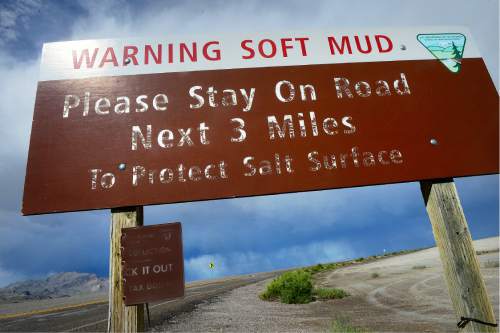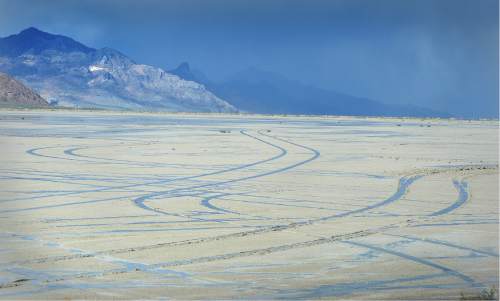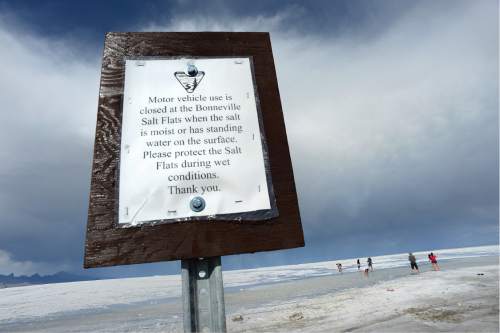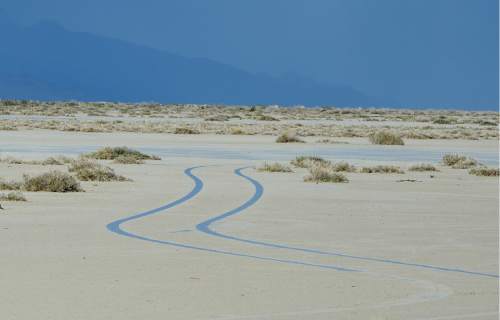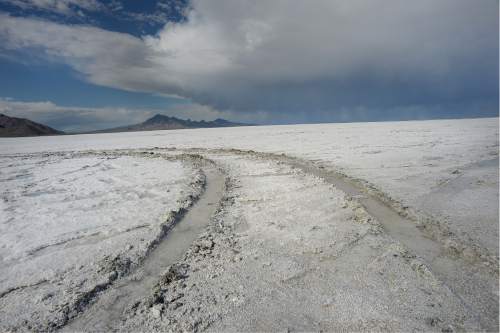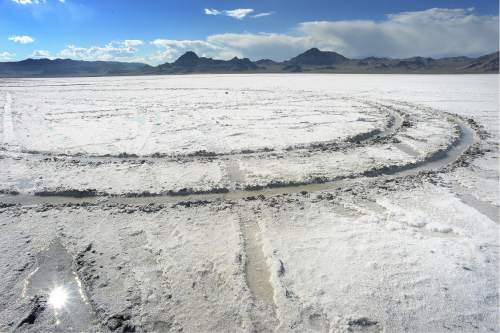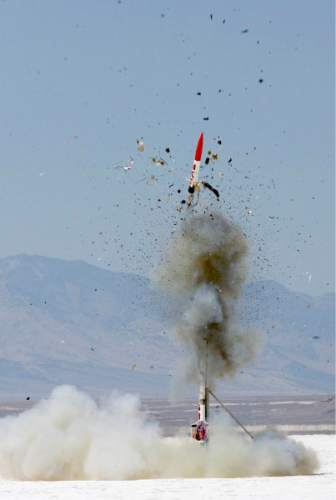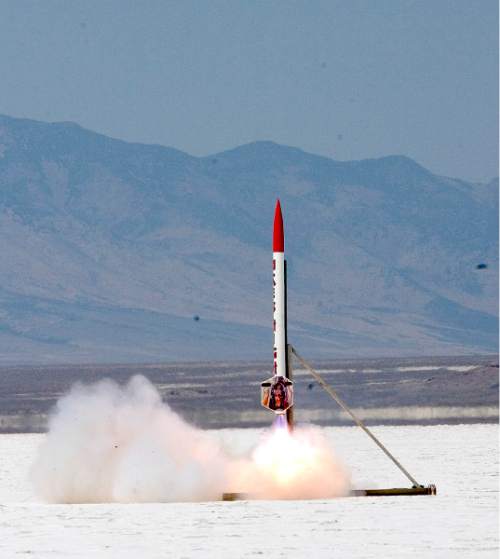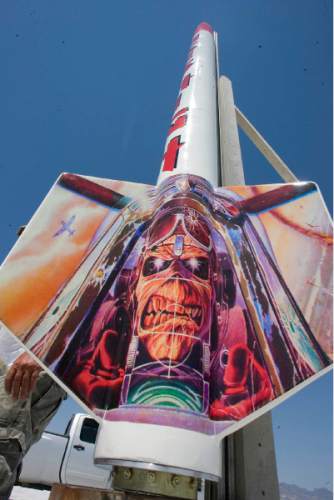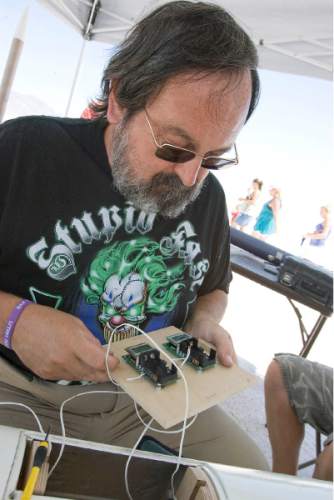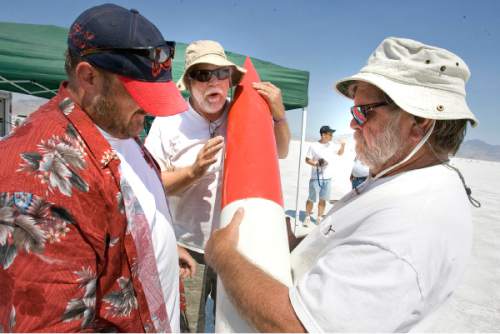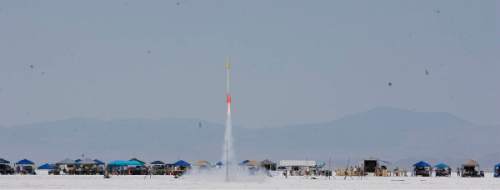This is an archived article that was published on sltrib.com in 2016, and information in the article may be outdated. It is provided only for personal research purposes and may not be reprinted.
One hundred and seventy years ago, the ill-fated Donner-Reed Party made a mistake that would deplete the travelers' resources and seal their snowy fate in the Sierra Nevada when they decided to take a shortcut across the Bonneville Salt Flats.
While the Donner Party trekked some 80 miles across the salt desert, the travelers' wagons became mired in the mud that lies hidden beneath the salt crust, forcing them to abandon supplies to lighten the load. The salt drove their oxen mad with thirst — some of the animals died; others broke free of their restraints and charged away, never to be seen again.
After the crossing, the wagon train remained at Pilot Springs for several days, working up the strength and courage to continue.
That historic event became the thematic precedent that today draws thrill-seekers to test their limits on the Bonneville Salt Flats, according to Vince Romney, director of a relatively new but growing 100-mile race that takes place annually on the flats.
Car enthusiasts, it turns out, aren't the only hobbyists for whom the salt flats have become a place of pilgrimage. Every year the salt flats draw hundreds intent on pitting the limits of art, physics or human athleticism against one of the most inhospitable landscapes on Earth.
But the salt flats have limits of their own. As scientists set out to investigate what initially appears to be a 30-year trend of declining salt conditions on the Bonneville Salt Flats, those for whom the flats have become an almost sacred space are beginning to talk about the possibility of a future without Bonneville.
—
Pushing the limits • This past spring marked the sixth year that some of the world's most intense endurance runners descended on Bonneville for Romney's race, the Salt Flats 100. But making his vision for the race a reality has been a struggle — in two of the past three years, he said, he's had to completely redesign the race course to avoid the salt flats, which were too wet to accommodate runners.
That could be problematic for the future of the race if the trend continues, Romney said. The main attraction of the Salt Flats 100 is the opportunity to run on the salt — not on the road next to the salt.
"The event doesn't have to have the salt, but that's what really draws people from all over the world," Romney said. "If we continue to lose that, we're probably not going to be able to continue with the kind of event that we've envisioned."
The participants who sign up for something like the Salt Flats 100 — which averages about 80 runners per year but has brought in as many as 120 with the recent introduction of an additional 50-mile course — aren't your typical runners, Romney said. They aren't interested in speed or in winning so much as in pushing themselves to see just how long they can run, even under the most extreme circumstances. These are the athletes who travel the world to run up the Andes Mountains or down to the depths of Death Valley.
Or across the Bonneville Salt Flats.
The course is so challenging, Romney said, that it has taken even elite ultra-marathoners by surprise.
"It's not some easy flat race," Romney said. "There's no shelter. Out here you've got the wind, the rain, whatever it throws out there, and there's no cover. And it's a real limit-pusher."
Only about 60 percent or 70 percent of the people who sign up for the race finish, Romney said, but some years they've seen more than half the runners quit before reaching the end — three years ago, for example, when the race got hit with freezing rain.
This past spring, Romney said, was also an especially successful race. The salt flats were underwater in some areas, he said, so organizers had to move some of the course onto paved roads. But the course still featured mud, weather and an 11,000-foot elevation change, so the runners still "had a good time."
"It was a stressful race with mud, etc., and that's what it's supposed to be, so it was a success," Romney said.
It may not sound like the definition of "a good time" to most other people, but Romney said that's exactly why he believes the salt flats need to be preserved — because historically, the salt flats have been the place where humans go to challenge the boundaries of nature.
—
Fly away home • Runners aren't the only athletes who take to the salt flats when they want to accomplish something no other human has done. Long-distance "flight" archers also see the Bonneville Salt Flats as a choice location for competition.
Flight archery has a long tradition that goes back to the 1600s, but as a sport it's relatively simple, said Kay Koppedrayer, secretary-treasurer for the USA Flight Archery Committee. The goal: Shoot an arrow as far as you can.
The salt flats are ideal because they present the archers with a wide-open, flat space free of vegetation where it's possible for an arrow to fly a mile or more, Koppedrayer said. It's also less isolated than similar sites, she said, a factor that became especially appealing after a famous archer died at a more remote location in Nevada in 1997.
With the potential for accidents in mind, the archers have settled into a Labor Day competition held on the salt flats not too far from Wendover for the past 15 to 20 years, Koppedrayer said. It's not usually a large event, she said, with perhaps 40 entrants, but it's generally quite competitive, with top archers traveling from as far away as Hungary, Mongolia and Australia.
With the tradition, she said, the flats have taken on an almost spiritual significance.
"There are other sites; it's just that we've happily settled in on the Bonneville Salt Flats," she said. "For some contestants, it's almost akin to a pilgrimage. There's this deep satisfaction — yes, we've come back again to the salt flats."
This sense of attachment to the landscape is the primary reason the decline of the salt flats has become a topic of conversation among the flight archers who regularly attend the event, Koppedrayer said. The quality of the surface isn't terribly significant to the archers, she said, but during the past five or so years, they've noticed a sort of "squishiness" to the salt as they've walked out to retrieve their arrows.
And below the upper salt crust, they're increasingly seeing a muddy layer below that Koppedrayer described as "a little wetter than Play-Doh."
"We were talking about it among ourselves and guessing that, within so many years, it's likely the salt flats will be gone," she said. "The moisture would percolate up and we would lose the crust."
While it's possible for the archers to find another location for their event, Koppedrayer said the sense that the changes they are observing could be beyond human control is disconcerting.
"We take it for granted sometimes, that something will always be there," she said. "But, no, it may not. Somewhere in the back of our head is an awareness that something is changing. We do feel a little bit helpless."
—
An otherworldly backdrop • Those who prefer to experience the thrill of danger more vicariously may discover the connection between Western wagon trains and tentacled, hive-minded aliens in the recently released "Independence Day: Resurgence."
Though the sequel wasn't able to secure a deal with the original movie's star, director Roland Emmerich said he made a point of including the Bonneville Salt Flats, the real-world location that stands in for the military base from which humankind launches its defense against the film franchise's persistent alien intruders.
Emmerich said he fell in love with the salt flats while searching for a unique filming location for the original "Independence Day." But the return nearly two decades later wasn't what he expected.
"We were a little disappointed because it all looked very beige," he said. "A windstorm that happened directly before [the crew arrived to film] put a lot of dirt onto the salt, which normally looks very white."
That whiteness is a big draw for film crews and photographers alike and has made Bonneville one of the most popular filming locations in Utah, said Mimi Davis-Taylor, a producer services executive with the Utah Film Commission.
"It's kind of otherworldly looking," she said. "Like on a photo shoot, the outfits and style really pop with the white background."
Davis-Taylor estimates that the Utah Film Commission gets some 20 to 30 inquiries every year about filming on the salt flats. Major productions such as "Independence Day" or Disney's "Pirates of the Caribbean," which also filmed on the flats, are rare, she said. Smaller operations for catalogs or commercials — especially car commercials — are more common.
It certainly made the RVs from "Independence Day" look cool, Davis-Taylor said.
—
'A beautiful place to fly' • Science fiction filmmakers aren't the only people who have looked at the Bonneville Salt Flats and seen the stars.
For the past two decades, the Utah Rocket Club has used the salt flats as its summer launchpad, taking advantage of the lack of flammable vegetation, and its location below a little corridor of vacant airspace near the Utah Test and Training Range. Usually in early August, the club hosts a three-day meet that draws more than 100 amateur rocketeers from all over the western U.S.
"The event that we hold is a regional launch for the hobby, and we get people from all over the West, and sometimes further," said Neal Baker, who sits on the Utah Rocket Club board. "And a lot of the draw is actually coming out on the salt flats. It's a beautiful place to fly."
Though a couple of the rocket club's members are professionals with experience at ATK and such, Baker said the bulk of its membership is comprised of amateur space enthusiasts who grew up in the midst of the space race.
Some make and launch to-scale models of real-life spacecraft, but others, like Baker, prefer to design and build their own rockets, some weighing hundreds of pounds, to see just how fast and how high they can fly.
"I love the design and construction," he said. "To build something that can go two times the speed of sound and to be able to recover it and fly it again — and to do all this in my garage — is something I'll always enjoy."
Lately, there's a new generation rising, Baker said — inspired by commercial rocket companies like SpaceX. And as the salt has thinned, Baker said, it's not clear what the future holds for the hobby.
"We have noticed a pretty significant thinning of the salt over the last five or six years at least," he said. "Year to year, it varies, as far as the conditions out there … but, overall, the salt does appear to be thinner, even toward the center."
So far, this hasn't had a major impact on the rocketeers, Baker said. The annual Hellfire Rocket launch has been canceled only once, Baker said, and that was because the flats were flooded.
As long as there isn't water on the flats, it doesn't matter to the rockets whether the salt is a little soft, so the club still hits the flats even if the salt has the consistency of — well, Baker said the best way to describe it is "mashed potato-like."
People sometimes get stuck in the mud under the salt, he said, but that isn't a new problem — just ask the Donner Party.
What has the rocketeers concerned, Baker said, is the possibility that the salt flats could be closed to the public in the future. The Utah Rocket Club would support that decision were it necessary to preserve the flats, he said, but if it happened, there wouldn't be anywhere else for the club to go during the summer. In its effort to identify a contingency plan, he said, the club hasn't come across another Utah location where it would be safe to fly.
And no other location is the salt flats, either.
"If we look at the span of time, this is probably part of a larger cycle, but it's affecting us today," Baker said. "I've seen so many different explanations of ways that the salt should be protected … but I have a hard time with limiting access to the salt, because I think it is an amazing place. It should be shared with everybody, not just racers, not just rocketeers, and not just with certain commercial companies."
Twitter: @EmaPen


